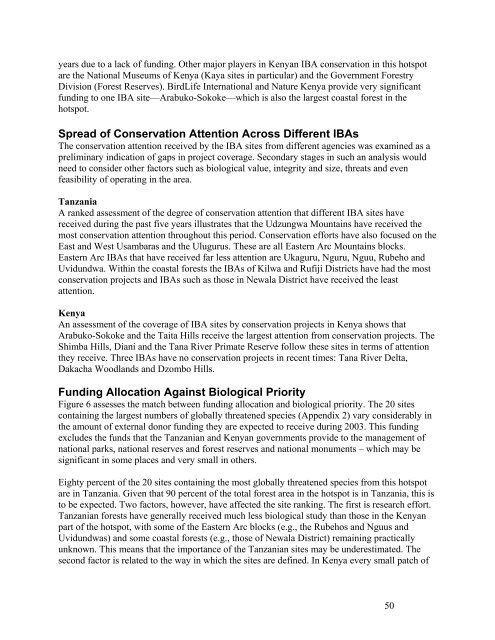Eastern Arc Mountains and Coastal Forests of Tanzania and Kenya ...
Eastern Arc Mountains and Coastal Forests of Tanzania and Kenya ...
Eastern Arc Mountains and Coastal Forests of Tanzania and Kenya ...
You also want an ePaper? Increase the reach of your titles
YUMPU automatically turns print PDFs into web optimized ePapers that Google loves.
years due to a lack <strong>of</strong> funding. Other major players in <strong>Kenya</strong>n IBA conservation in this hotspotare the National Museums <strong>of</strong> <strong>Kenya</strong> (Kaya sites in particular) <strong>and</strong> the Government ForestryDivision (Forest Reserves). BirdLife International <strong>and</strong> Nature <strong>Kenya</strong> provide very significantfunding to one IBA site—Arabuko-Sokoke—which is also the largest coastal forest in thehotspot.Spread <strong>of</strong> Conservation Attention Across Different IBAsThe conservation attention received by the IBA sites from different agencies was examined as apreliminary indication <strong>of</strong> gaps in project coverage. Secondary stages in such an analysis wouldneed to consider other factors such as biological value, integrity <strong>and</strong> size, threats <strong>and</strong> evenfeasibility <strong>of</strong> operating in the area.<strong>Tanzania</strong>A ranked assessment <strong>of</strong> the degree <strong>of</strong> conservation attention that different IBA sites havereceived during the past five years illustrates that the Udzungwa <strong>Mountains</strong> have received themost conservation attention throughout this period. Conservation efforts have also focused on theEast <strong>and</strong> West Usambaras <strong>and</strong> the Ulugurus. These are all <strong>Eastern</strong> <strong>Arc</strong> <strong>Mountains</strong> blocks.<strong>Eastern</strong> <strong>Arc</strong> IBAs that have received far less attention are Ukaguru, Nguru, Nguu, Rubeho <strong>and</strong>Uvidundwa. Within the coastal forests the IBAs <strong>of</strong> Kilwa <strong>and</strong> Rufiji Districts have had the mostconservation projects <strong>and</strong> IBAs such as those in Newala District have received the leastattention.<strong>Kenya</strong>An assessment <strong>of</strong> the coverage <strong>of</strong> IBA sites by conservation projects in <strong>Kenya</strong> shows thatArabuko-Sokoke <strong>and</strong> the Taita Hills receive the largest attention from conservation projects. TheShimba Hills, Diani <strong>and</strong> the Tana River Primate Reserve follow these sites in terms <strong>of</strong> attentionthey receive. Three IBAs have no conservation projects in recent times: Tana River Delta,Dakacha Woodl<strong>and</strong>s <strong>and</strong> Dzombo Hills.Funding Allocation Against Biological PriorityFigure 6 assesses the match between funding allocation <strong>and</strong> biological priority. The 20 sitescontaining the largest numbers <strong>of</strong> globally threatened species (Appendix 2) vary considerably inthe amount <strong>of</strong> external donor funding they are expected to receive during 2003. This fundingexcludes the funds that the <strong>Tanzania</strong>n <strong>and</strong> <strong>Kenya</strong>n governments provide to the management <strong>of</strong>national parks, national reserves <strong>and</strong> forest reserves <strong>and</strong> national monuments – which may besignificant in some places <strong>and</strong> very small in others.Eighty percent <strong>of</strong> the 20 sites containing the most globally threatened species from this hotspotare in <strong>Tanzania</strong>. Given that 90 percent <strong>of</strong> the total forest area in the hotspot is in <strong>Tanzania</strong>, this isto be expected. Two factors, however, have affected the site ranking. The first is research effort.<strong>Tanzania</strong>n forests have generally received much less biological study than those in the <strong>Kenya</strong>npart <strong>of</strong> the hotspot, with some <strong>of</strong> the <strong>Eastern</strong> <strong>Arc</strong> blocks (e.g., the Rubehos <strong>and</strong> Nguus <strong>and</strong>Uvidundwas) <strong>and</strong> some coastal forests (e.g., those <strong>of</strong> Newala District) remaining practicallyunknown. This means that the importance <strong>of</strong> the <strong>Tanzania</strong>n sites may be underestimated. Thesecond factor is related to the way in which the sites are defined. In <strong>Kenya</strong> every small patch <strong>of</strong>50
















